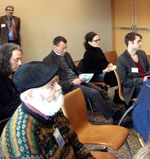What happens when America's largest museum complex gets on board perhaps the greatest communications revolution? During a two-day interactive gathering, January 2324, 2009, 30 activists in the digital world joined Smithsonian curators and other museum specialists to explore the intersection of Web 2.0 technologies and the Smithsonian's 19 museums and National Zoo.
The event, Smithsonian 2.0: A Gathering to Re-Imagine the Smithsonian in the Digital Age, addressed a primary question—how to make the vast resources of the Smithsonian more digitally accessible. Concurrently, experts discussed how Web 2.0 technologies influence the dissemination and interpretation of museum collections and how this dissemination affects the functions of historians and curators.
As the description of the gathering asks,
How does the Smithsonian effectively serve its growing virtual visitors? How does it deliver to those visitors the 137 million artifacts, works of art, and scientific specimens in its collections along with the expertise that goes with them? How does it do so in an engaging, educational manner that evokes the power and inspiration of its finest exhibitions and presentations?
The Smithsonian's target audience in the digital age is the teenage through college demographic, most of whom will largely experience and use the collections and educational resources online.
Michael Edson, Director, Web and New Media Strategy, at the Smithsonian, encourages a vision of a Smithsonian Commons, a concept rooted in the "democratization of knowledge and innovation" and broadly defined as a "set of resources maintained in the public sphere for the use and benefit of everyone." And what are the benefits to a museum? Edson points out that ideas don't stand alone, but are built on the ideas of others. A commons, perhaps much like the collaborative classroom, provides access to the raw materials of innovation and encourages networking and creativity in their use. (Edson's PowerPoint presentation is online on Slideshare with an accompanying full-text version).
Catch up and contribute to the discussion which continues on the Smithsonian 2.0 blog and, among others, currently includes ideas from Lee Rainie, Director, Pew Internet & American Life Project, Bruce Wyman, Director of Technology, Denver Art Museum, and other responses and referrals to papers and resources from public historians in the Smithsonian and other museum venues.
Photos from the conference reside on Flickr, and discussion also continues on the Facebook group, Smithsonian 2.0. The Washington Post reported the event.
(Smithsonian resources for educators link from the conference website as well.)
